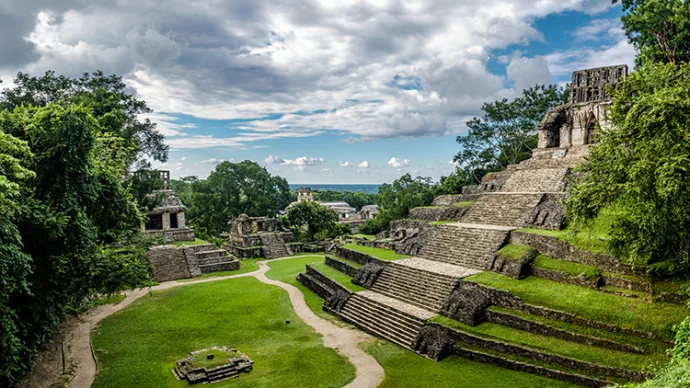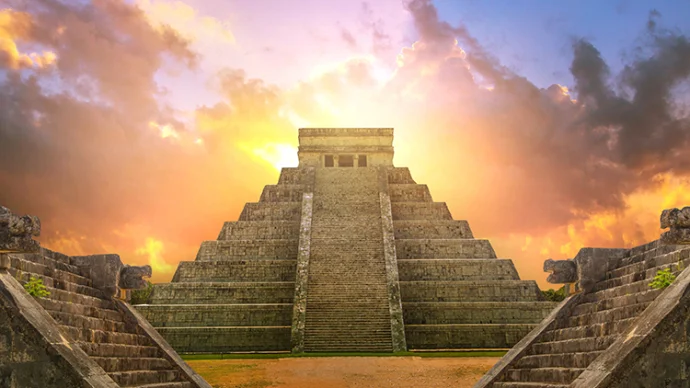
About Palenque
Palenque in Mexico is an important Maya archaeological site located just outside the modern city by the same name.
History of Palenque
It is thought that Palenque was first inhabited in around 100BC and excavations have uncovered writings about a king who ruled there in the fifth century AD, however the city was attacked several times by the inhabitants of neighbouring cities.
It was from the seventh century AD that Palenque began to develop once more under the rule of Pakal the Great (sometimes spelt “Pacal”). During his reign between 615 and 683 AD, Pakal built many of Palenque’s most impressive structures and they are often considered to be some of the most important pieces of Maya architecture. Pakal’s works were continued by his son, Kan B’alam.
In approximately 711 AD, Palenque was attacked once more and, by 900 AD it was deserted. Little attention was given to Palenque by the Spanish, and it was only in the 1830s that the ruins were taken notice of. European explorers Desire Charnay and Alfred Maudslay both took extensive photographs of the site.
In the 1950s, Mexican archaeological teams moved in to do the first real excavation of the site: it’s estimated that even today, only about 5% of the site has been uncovered.
Many of Palenque’s temples centre off the central plaza, a marvel in its own right as it was built over the river, requiring advanced engineering mechanisms. It’s also worth remembering that everything at Palenque was built without metal tools, pack animals or the wheel.
Each of the structures in Palenque is ornate and lavishly decorated, bearing inscriptions chronicling the history of the city, which was probably the capital of the region. In fact, Palenque has the honour of having one of the best Maya inscriptions ever found, located in the Temple of the Inscriptions and telling the story of Palenque.
Palenque today
The remoteness of Palenque lends to its atmosphere, and it’s an incredible place to visit. Go early in the morning to enjoy the site without crowds and before it gets too hot – the sticky jungle heat is draining. If the weather’s right, you might see the ruins shrouded in early morning mist. Equally, sunset is a good time to visit as the crowds head home.
Wear good shoes: there’s plenty to climb and you’ll end up walking through jungle paths. There are vendors outside as well as guides offering their services, should you want refreshments or more information.
There’s a relatively small but interesting museum containing many of the finds from Palenque which is worth visiting.
Templo de las Inscripciones
Built in the 7th century as a funerary monument, the temple contains the second longest Maya glyphic text known. It records about 180 years of Palenque’s history. In the 1950s, archaeologist discovered a hidden passageway which led to Pakal’s tomb: highly decorated and elaborate, the tomb was an important discovery as it proved that the use of the pyramids could be multifaceted i.e. both a temple and a tomb.
El Palacio
El Palacio is located at the centre of Palenque, and is a complex rather than one building. Named El Palacio (the palace) because it was used by the Maya equivalent of aristocracy, it would have had ceremonial, bureaucratic and social functions. There’s also evidence that El Palacio had baths and saunas filled with fresh water, which was no small feat of engineering and plumbing.
Getting to Palenque
Palenque is remote. Located in the heart of Chiapas, you’ll need to take twisty mountain roads to get here from Villahermosa or San Cristobal de las Casas by bus – there are less frequent services from further afield too. The town of Palenque has decent accommodation options, and it’s easy to get a combi to the ruins from here.
Featured In

Mexico Ancient Cities
Among Mexico's endless coastline, vibrant and modern cities, and tasty cuisine are a number of ancient historical cities. Here's our pick of 10 of the best the country has to offer.

Mexico Historic Sites
Among Mexico's endless coastline, vibrant cities, fragrant cuisine, and stunning nature are a number of fascinating historical sites. Here's our pick of 10 of the best the country has to offer.




















